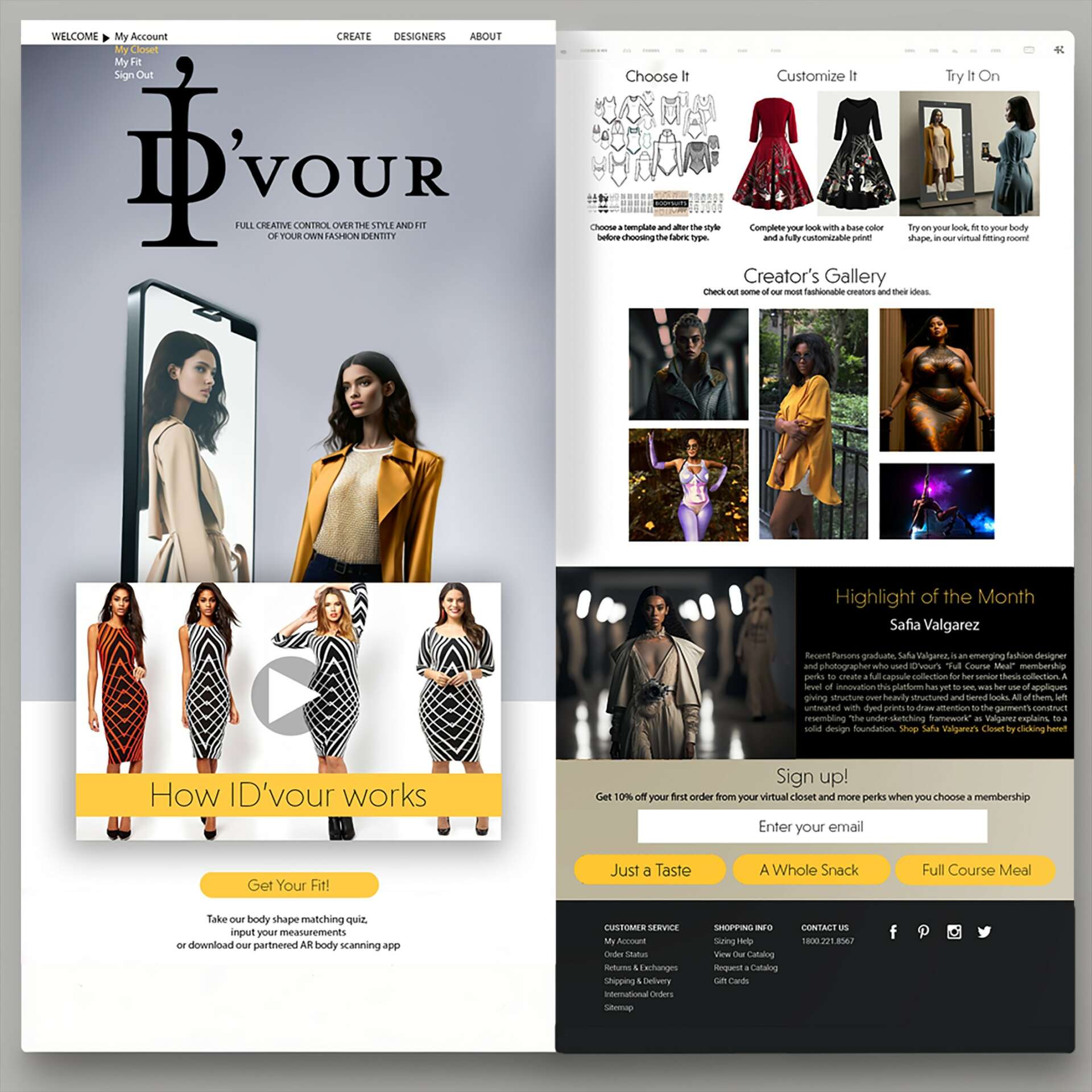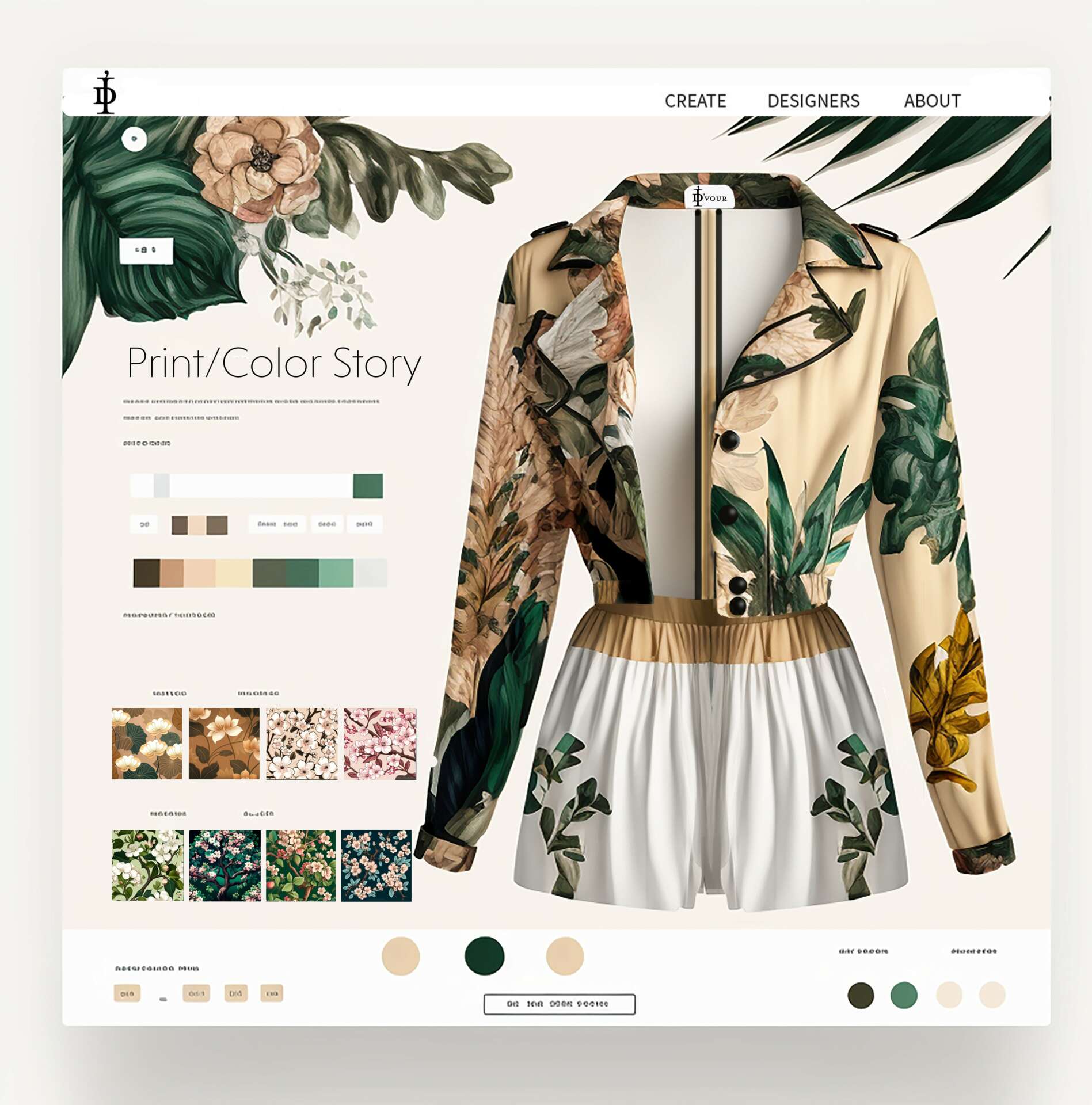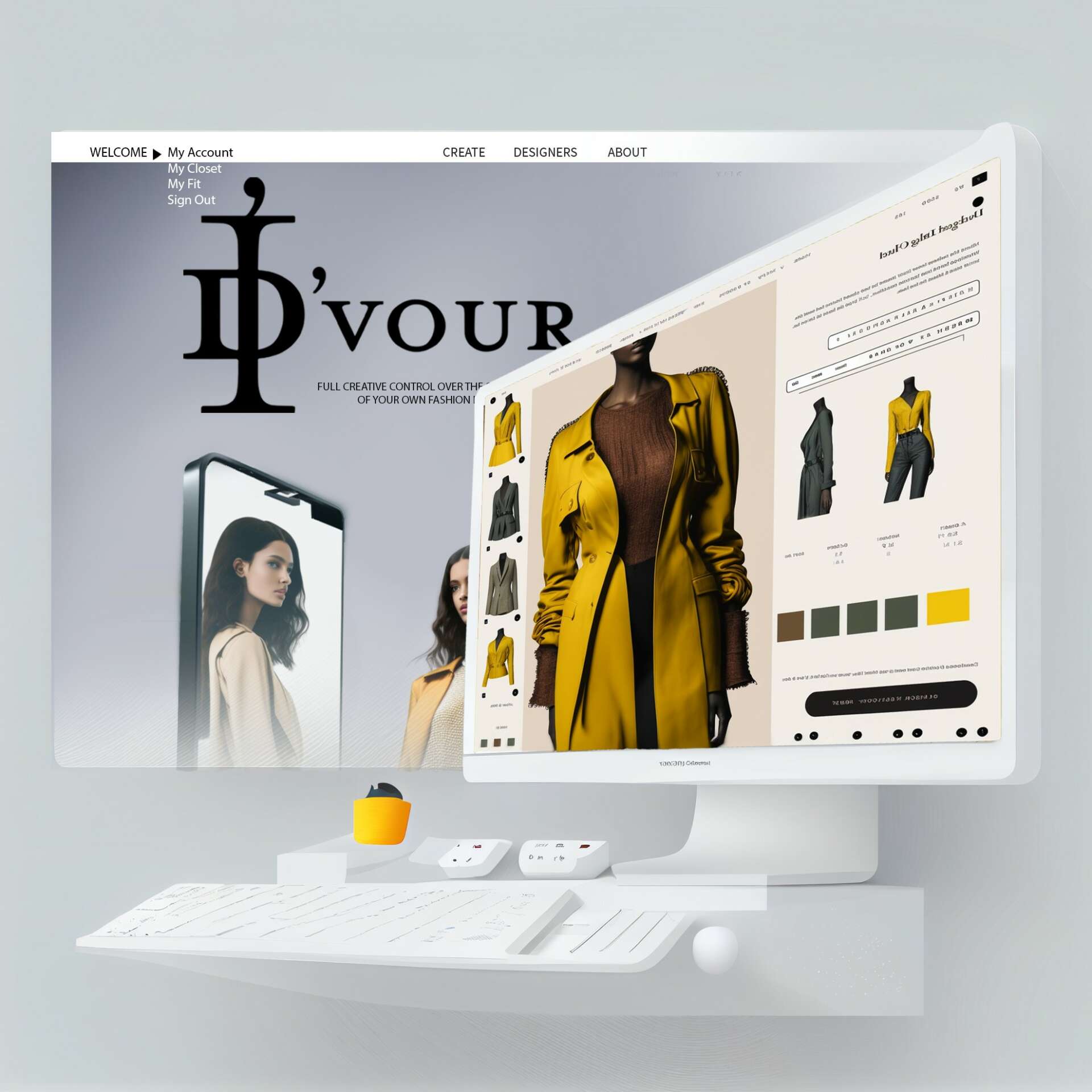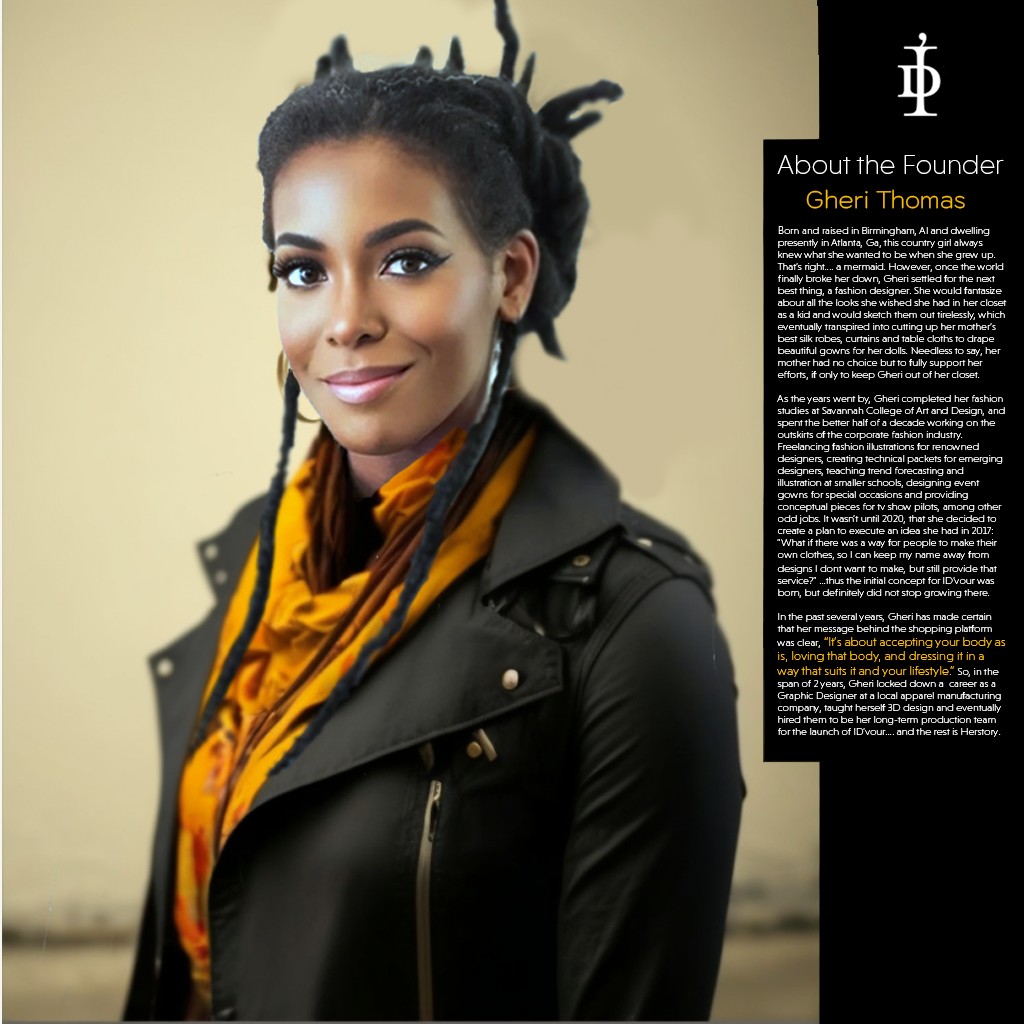We caught up with the brilliant and insightful Gheri Thomas a few weeks ago and have shared our conversation below.
Gheri, appreciate you joining us today. Risk taking is something we’re really interested in and we’d love to hear the story of a risk you’ve taken.
The act of starting a business, in itself, is the risk. I am very open and honest about the fact that I have been learning everything as I go and terrified every step of the way. From the moment I came up with the concept for ID’vour in 2017, I had no idea how I would execute it. Not only due to the financial resources being nonexistent, but that it was unheard of for manufacturers to produce for “made-to-order” slow fashion brands.
Most minimums are still bulk orders of 500 pieces, same style, maybe different color ways, at best. ID’vour’s logistics, alone, of having one look that could be altered in 3 different ways coupled with a print that could be manipulated by the taste of the user set me up for many “NOs” from apparel manufacturers.
So I hunted around for manufacturers with incredibly low minimums, found one who only required 50 and got a job working there as their graphic designer in order to learn more about the infrastructure of that factory, and for the discounts they give to employees.
Essentially, I have rearranged the daily structure of my life to see this brand through to it’s fruition, with the reason why being that I want to answer to the millions of women who are tired of not being able to find the clothes they want to wear according to their lifestyles…in their size. It’s beyond ridiculous that this problem has not been solved yet. I don’t care how much it costs me, I don’t want to leave this planet without creating a brand that can truly boost the confidence of women and steer them towards self-love, body acceptance and freedom of self-expression by way of dress.


As always, we appreciate you sharing your insights and we’ve got a few more questions for you, but before we get to all of that can you take a minute to introduce yourself and give our readers some of your back background and context?
There was never a time in my life that I can remember where I was not brainstorming and sketching out looks that I wished were in my closet, but my mother had me to start signing and dating my fashion sketches at the age of nine, and before then I was cutting up all her curtains and draping tiny dresses onto my dolls, so I can honestly say I was born into this craft!
Growing up in Alabama, the arts were not a heavily supported field and even though I was the first kid who knew exactly what they wanted to be as an adult and never waned from it, advisors had a difficult time setting me up on a course towards a career as a fashion designer.
Many breaks fell into my lap out of pure luck. For example, I just so happened to be in my high school’s theater program on the costume crew, and we just so happened to take a trip to SETC in Atlanta and I just so happened to win an award for best costume design, and a booth advertising for Savannah College of Art and Design just so happened to be at the neighboring event space. SCAD was the only school I applied for, and I just so happened to get accepted.
I knew nothing before being classically trained in sewing techniques, pattern-making, traditional drafting, draping and Computer-aided pattern design until SCAD. All I knew was fashion illustration and trend forecasting, but although I was able to highly refine my skills set, I still learned very little about the business of fashion by the time I graduated in 2013.
Life as an independent contractor taking on commissions for local clients starting up their own fashion brands taught me a lot about the ins and outs. I watched multiple companies make mistakes and was paid to help them do so. However, in 2020, I decided it was time to take the dive and start making my own mistakes. I joined an accelerator program for one month, hired a brand strategist, and UX designer, a team of lawyers and started networking and researching like a madwoman to bring ID’vour from a dream to a reality.
ID’vour is a fully customizable online shopping experience where fashion technology meets inclusivity. There are 3 steps to creating your own clothes.
1. A user can pick a basic garment and alter it to their liking (take off sleeves, raise the hem, add pockets, change the collar, etc).
2. Then, they can pick a print motif from an assortment of seasonal graphics and customize it (change the colors, minimize or maximize the scale of the repeat print, etc.)
3. Finally, the user can try their creation on virtually before ordering it. This can be achieved in various ways depending on the user’s status of engagement.
-Just a Taste- The easiest but least accurate result. Take the fit matching quiz and upload a standing selfie. (Gives you a flat, 2D version of yourself in your created look)
-A Whole Snack- The more involved and more accurate result. Follow the fit guide’s how to video and manually input your measurements. (Gives you a 3D avatar in the sites virtual fitting room and 360 degree view of the garment)
-5 course Meal- The most accurate and high tech result. Download the partnered fit scanning app onto user’s phone, compliments of ID’vour. (Gives you an AR version of yourself wearing the garment.)
I want the experience to be fun, immersive, freeing and forward-thinking for users. I also want ID’vour to be incredibly disruptive to the fashion industry as a whole. Not only am I providing my consumer base with the tools they need to set their own trends instead of following, but I give a platform for the many who feel unseen to finally showcase their personal style made just for them by them.
Other ways ID’vour is shaking things up is that our sizing system is not based on numbers, but more on shape, to provide a more consciously tailored look. One size 8 does not fit all size 8s. And for the love of all that is fashion, everything above an XXL should not be shaped like a burlap sack. If a size 16 user sees a size 4 model wearing low v-cut polkadot mini dress on a website and wants that same dress, they should not be limited by the crew-neck, mid-knee length version of the same dress!
Likewise, with slow-fashion, made-to-order styles, ID’vour cuts back on the pollution of mass production and unnecessary waste. That is one of my biggest reasons for sticking to my business plan, regardless of the backlash I have received from many manufacturers. We have to find more sustainable practices to lessen the amount of clothing woven from materials that are extremely harmful to the environment once they have gone through their life cycles. This is not discussed enough, but it is an extreme environmental issue that I am determined to bring to national consumer awareness before I die. I feel it is a grand part of my life’s purpose to try my best to create safer ways to discard of clothing, starting with how many are produced in the first place. I hope to bring consumerism back to quality over quantity and move on to other sustainable practices from there. Pollution from the incineration of outdated clothing is the elephant in the room that fashion industries choose to ignore. And how do we eat an elephant? One bite at a time.
I have been waiting for a long while to reveal why I called my brand, ID’vour. I have chosen this magazine to finally lay it out and am so grateful for the opportunity to do so.
![]()
Can you talk to us about manufacturing? How’d you figure it all out? We’d love to hear the story.
I currently manufacture my products in America. I refined my fashion sketching skills and learned how to sew, drape designs and draft patterns, both traditionally and digitally, in college. I am currently teaching myself CLO3d and Accumark to aide in avatar clothing presentations of accurate patternmaking in Gerber tech. I have also recently downloaded Blender to begin teaching myself how to create environments and my own avatars that can be input into a program called Style 3D that eventually want to purchase as the main in-house program for ID’vour’s function.
Everything is still a work in progress. In the meantime, the operation is run traditionally for the most part, aside from digital patternmaking in Gerber tech. I work with my manufacturer to produce one-off items per client. From a traditional standpoint, it is almost as if we create a new sample for every client, however I have created a streamlined way of doing it. Picture it like putting an order in at a restaurant. The cooks know the menu very well, they can make it as is very quickly, but the customer can always subtract a side for something else, or add garnishing. It’s a similar concept to that, we have all the basic looks ready to go, and we have an assortment of additives or subtractions also ready to go, giving a “cookie-cutter” template of sorts to pull from when we receive an order online.
I started off making everything myself, for individual clients or for groups attending events during my days as an independent contractor. I did not necessarily have a name for a business, I was simply a freelance fashion designer. However, as I always wanted to find a way to delete myself as a middle man to people having custom designed clothing, I eventually came up with the idea in 2017 and hunted for about 3 years for the right manufacturer. I finally came across one with a minimum order low enough to sustain the start up costs and began producing some samples of just a personal collection. The orders have begun pouring in for looks from this first collection and the website is not even fully launched yet, so I am excited for the moment when clients will realize the opportunities they will have to either create their own looks or shop other creator’s collections.


How did you put together the initial capital you needed to start your business?
This has all been self-funded thus far. Since 2019, I have spent around $25,000 out of pocket funding this start up. It’s the reason why it has been a fairly slow, but consistent growth path. Though I have consulted with professional associates on the best ways to generate funding for my brand and have gotten many mixed reviews and wary advise.
I initially sought out a capital investor, but my initial risks were way too high. Additionally, I was warned about the pressures that would be put on me to return the investment within a short deadline, and given that I am almost certain I will make some mistakes along the way, I thought… maybe I should not play with their money, even if I have very little doubt in my own business plan will be successful. However, I learned a lot about what investors look for and decided to refine my pitch deck answering to them as if I have an investor interested.
1. Capability Risk (is it scalable?)
2. Design Risk (Is the product well made?)
3. Development Risk (Is your turnaround prompt?)
4. Economic Risk (Can you survive economic change?)
5. Economic Life Risk (Will you become obsolete? Will consumers still buy even in distress?)
6. Funding Risk (Is it really worth funding, will there be an easy return on investing? 20% or more return?)
7. Regulatory Risk (Can the business efficiently run itself, if you miss some days of work?)
8. Maintenance Risk (How much does it cost to keep up?)
9. Management Risk (Are you capable of managing employees varying personalities?)
10. Operations Risk (Do you understand how to resource?)
11. Procurement Risk (What is your supply chain?)
12. Research Risk (What’s the initial R & D?)
13. Technology Risk (No code platforms vs intricate coding/upkeep)
14. Volume Risk (Is there a real demand?)
*Extra things to consider: Who has done this before? What sets you apart from your competitors? Do you truly know what you are getting yourself into with Starting up a business?
Then I decided to apply for grants. However, many grants prefer for you to have been in business for at least 2 years and have well documented tracking. Which is similar to investor requirements as well. I have spent that last 2 years just trying to create a functioning website that can at the very least detail the concept of the brand accurately and have people subscribe to show levels of interest. It’s slow going to say the least.
Then I thought about crowd funding, which is still a strong possible for me in the near future. Even with that, in order to assure you have a fighting chance at receiving the amount you wish to gain, you have to have an amazing presentation to get people excited to give money towards your start up. I am currently building that presentation to reflect the level of excellence I hold the standard of the brand to be.
All of that leads me to where I am now, paying out of pocket for accelerator programs to help me with presenting and pitching. Paying for a brand strategist to help me keep everything cohesive and according to plan. Paying lawyers for trademarking and copywriting protection. Paying a manufacturer to produce the initial collections based off of my samples. Paying a photographer, studio time and models to create visuals for the website launch. Buying a new laptop, home sergers and sewing machines, a drafting table, dress forms, fabrics and endless sewing supplies, all so I can continue to work from home in case there comes a time when I cannot afford to pay the manufacturer to produce for me.
I think I am in a very unique position that is not exposed often enough. I chose to answer this question for that reason. I will not even be eligible to apply for a loan, or to peak the interest of an investor, or to give a compelling grant proposal ….. or even get a group to rally behind my crowd funding until I first have invested heavily into the business myself. This is the risk I alluded to earlier when stating that founding a start up is the risk, all on it’s own. I don’t have a wealthy family member willing to give me an initial $100,000 to chase my dreams. It’s just me and my 5 figure job working as a graphic designer, hustling as a fashion designer, putting money to the side to spend on my start up and networking like a my life depends on it…. because it very much does.
I have, however, recently decided to give Patreon.com a shot. I am already making moves on my own, a few monthly subscription based payouts toward the brand would surely be more helpful than nothing at all. For those who have stated that they are willing to support me, or want more information on all that I am building with ID’vour, I can now direct them to that platform to become a patron and stay up to date with my progress. I look forward to seeing what results that may yield for me as I stay consistent with my social media presence this year.
Contact Info:
- Website: https://idvourstore.onuniverse.com
- Instagram: @IDvour.store
- Facebook: https://www.facebook.com/IDvour
- Linkedin: https://www.linkedin.com/company/id-vour
- Twitter: https://twitter.com/idvour
- Other: http://www.patreon.com/idvour


